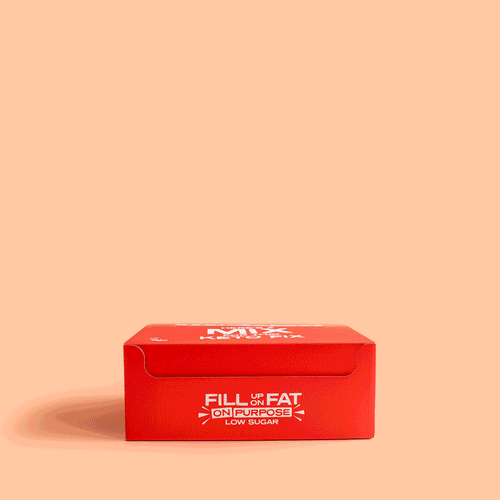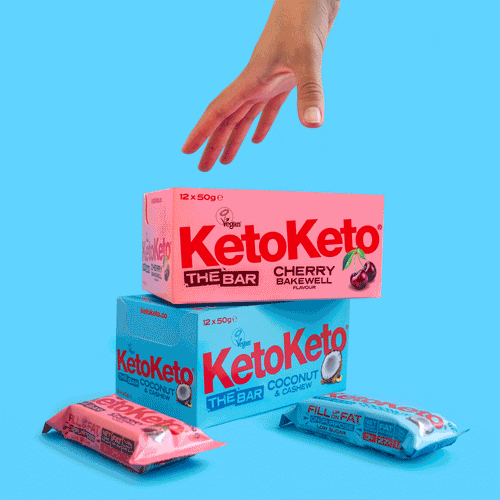Fasting tends to go hand-in-hand with a Ketogenic diet, because it can quickly put your body into a state of ketosis. For those of you who are new to Keto and the concept of fast days, you’ll likely have lots of questions about what fasting involves and how you should end a period of not eating. Look no further, we have all the what, hows and best tips for you to to approach fasting while on Keto:
What Is Fasting?
Intermittent fasting, IF for short, is going without food for a set period of time. It’s a popular way of eating for many on the Keto diet as it helps your body go into a state of ketosis - fuelling your body by burning fat.
When your body functions without food for a long period of time, some say as little as 12 hours without eating, your body will begin to burn stored fat for energy.
If you’ve had success with Keto and are ready to take things up a notch, combining IF with a Ketogenic diet is a great way to up your Keto level. If you want to see quick results, this may be the way to go. This is especially true if you find yourself hitting a plateau with your health and weight-loss goals. Adding intermittent fasting can help you break through any walls that have come up.
You may also find that your Keto diet makes you feel more satiated and you can last longer between meals. Intermittent fasting may be a natural progression for you as your appetite decreases, and you feel more satisfied with the fats and proteins fuelling your activities.
How Does Fasting Work?
It’s really important that you don’t go all-in to begin with, don’t take on Keto and IF at the same time! This would put your body under too much stress and you could end up feeling quite unwell.
Once you’ve established a comfortable routine on Keto and your body has adjusted to being in ketosis, you can begin to practice intermittent fasting. So how do you start?
Plan specific times when you will not eat. You may want to start by making sure you have at least 12 hours of fasting at night time. This is an easier option for many as it’s a natural time to eat less and you’ll be asleep for the main portion of your fasting period. You could put this into practice by not eating later than a specific time in the evening, or having breakfast later in the morning.
There are other ways to approach IF; some people follow the popular 5:2 intermittent fasting regime, where 5 days are ‘normal’ eating and 2 days are extremely low-calorie ‘fast’ days (no more than 500 calories). Others may not eat at all for a whole 24 hours or more. While some take on IF by eating only at specific times, such as having an 8 hour window to eat, followed by 16 hours of fasting.
How Should I Break My Fast?
It’s crucial that you consider and plan how you’re going to break your fast, as part of your fasting regime. Once you’ve decided the type of fasting you’d like to practice, you must prepare how you’re going to break it too.
When you fast, your insulin sensitivity will increase and your digestive enzymes will decrease. If you haven’t taken the time to carefully consider how you’ll break your fast, you’re likely to end up doing the wrong things that will create problems for you. If you eat the wrong things in the wrong way after a period of fasting, your blood glucose levels will quickly spike and digestive issues will surface that’ll undo all the miraculous work of your fast.
Instead, set out how you’re going to end your fast so that you can ease your body back into processing food without any issues and maintain ketosis.
5 Top Tips To End Your Fast
1. Go Gently With Liquids
One of the best ways to break your fast is by enjoying a cup of broth or soup. Warm liquids will be much easier for your digestive tract to process without issues. Broths and Keto-friendly soups are also packed with plenty of vitamins and minerals to keep you feeling well and provide your body with the nourishment it needs. This is a great gentle way to break your fast that will ease your body back into processing food. Continue to drink plenty of water too to keep you well hydrated.
2. Stick To Small Meals
As you begin to eat again, take your time and eat small amounts at first. You may find that a cup of broth satisfies your appetite for quite a long time. Wait to see how hungry you really feel before eating more. When you do find your appetite increasing, prepare a small meal so that your digestive system can easily adapt and process the food. If you break your fast with a rich and/or substantial meal, you’ll likely suffer with gastrointestinal upset such as; stomach pain, nausea, gas and bloating.
3. Avoid All Carbs
Obviously the amount of carbs you’ll be eating are minimal anyway, but it’s especially important to not break your fast with even your small allowance of carbs. Your insulin sensitivity will have significantly increased whilst fasting, and any carbohydrates you consume afterwards are likely to cause a dramatic spike in your blood glucose levels. Instead, stick to healthy fats and proteins for the first day after your fast - to ease yourself back into regular eating.
4. Enjoy The Best Whole-Foods
You’re likely used to eating good-quality whole-foods on Keto too, but it’s even more important after a fast. Your body will be especially sensitive to processed foods that are more complex to break down.
End your fast with Keto-friendly whole foods that will nourish your body and optimise all the feel-good benefits of your fast. Even certain whole-foods can be taxing on your digestive system such as; raw vegetables, nuts and seeds, so carefully consider which whole-foods to include in your break-fast meal. Cooked non-starchy vegetables, healthy fats and natural soups or broths are ideal.
5. Support With Supplements
It’s a great idea to continue taking supplements such as electrolytes whilst you break your fast. You’ll still be consuming a tiny amount of calories in the hours after your fast, so you’ll continue to need supplements to provide your body with vital vitamins and minerals as you move back to eating.

The KetoKeto Mix Box
When we surveyed some of our most regular customers, over half said they love to have KetoKeto bars just after they break fast in the afternoon. It suppresses their appetite and keeps them going to dinner! Grab a mix of every flavour, so you're spoilt for choice.
The Value Of Fasting
Listen to your body and learn from your experience of fasting - some things might make you feel worse, whilst other things are likely to improve the benefits of fasting. The point of fasting is to cleanse, heal and restore your body for balance and optimum health. You ought to feel more energised and satiated following a period of fasting.
Start with the easiest and most appropriate option of IF for you and your lifestyle. This will look different for each individual, and you don’t need to copy the same style of fasting as another Keto-er.
Above all, take good care of yourself. Drink plenty of fluids, support yourself with important supplements such as electrolytes, and break your fast gently using our top tips. You’ll discover a new way to feel great and achieve results, optimise your Keto lifestyle and upgrade your health.






